4.02.2025
Introduction
This paper builds on a preliminary study presented by the authors at the 2nd International
1
Orbital Debris Conference . While there is overlap in the text, this article greatly expands upon
that initial work.
On 4 November 2022, a 20 tonne Long March 5B (LM-5B) rocket body reentered the
atmosphere over the Pacific Ocean. This reentry location was a result of chance rather than
design, as the rocket body was abandoned in orbit and left to return to Earth in an
uncontrollable manner. In the evening before its reentry, the rocket body was predicted to
reenter over southern Europe. This led the European Union Space Surveillance and Tracking
organisation (EU SST) to raise concerns with the European Aviation Safety Agency (EASA),
which in response issued a Safety Information Bulletin (SIB) recommending that national
authorities ‘consider implementing and notifying airspace restrictions on a path of minimum
2
70 km and up to 120 km on each side of the estimated re-entry trajectory’ . The following
morning, Spanish and French authorities elected to do just that, and closed part of their
airspace.
Of the 15 notices to air missions (NOTAMs) issued across Europe for the reentry, four were
zero-rated, meaning the airspace was effectively closed (Fig. 1). These closures delayed 645
3
aircraft by an average of 29 min, and covered central Spain, southern France, and Monaco .
Particularly disruptive were the short lead times between the announcement of a closure and
its implementation—in some cases, aircraft already in flight had to be diverted or instructed to
return to their departure airport. Surrounding states, including Portugal, Italy and Greece,
were also under the reentry flight path and subject to the same reentry risk, but elected not to
close their airspace. They then saw an unexpected increase in air traffic from diverted flights,
which carried different, operational risks. The incident highlighted, among other things, a lack
of preparation for this eventuality and a lack of harmonization of responses among states.
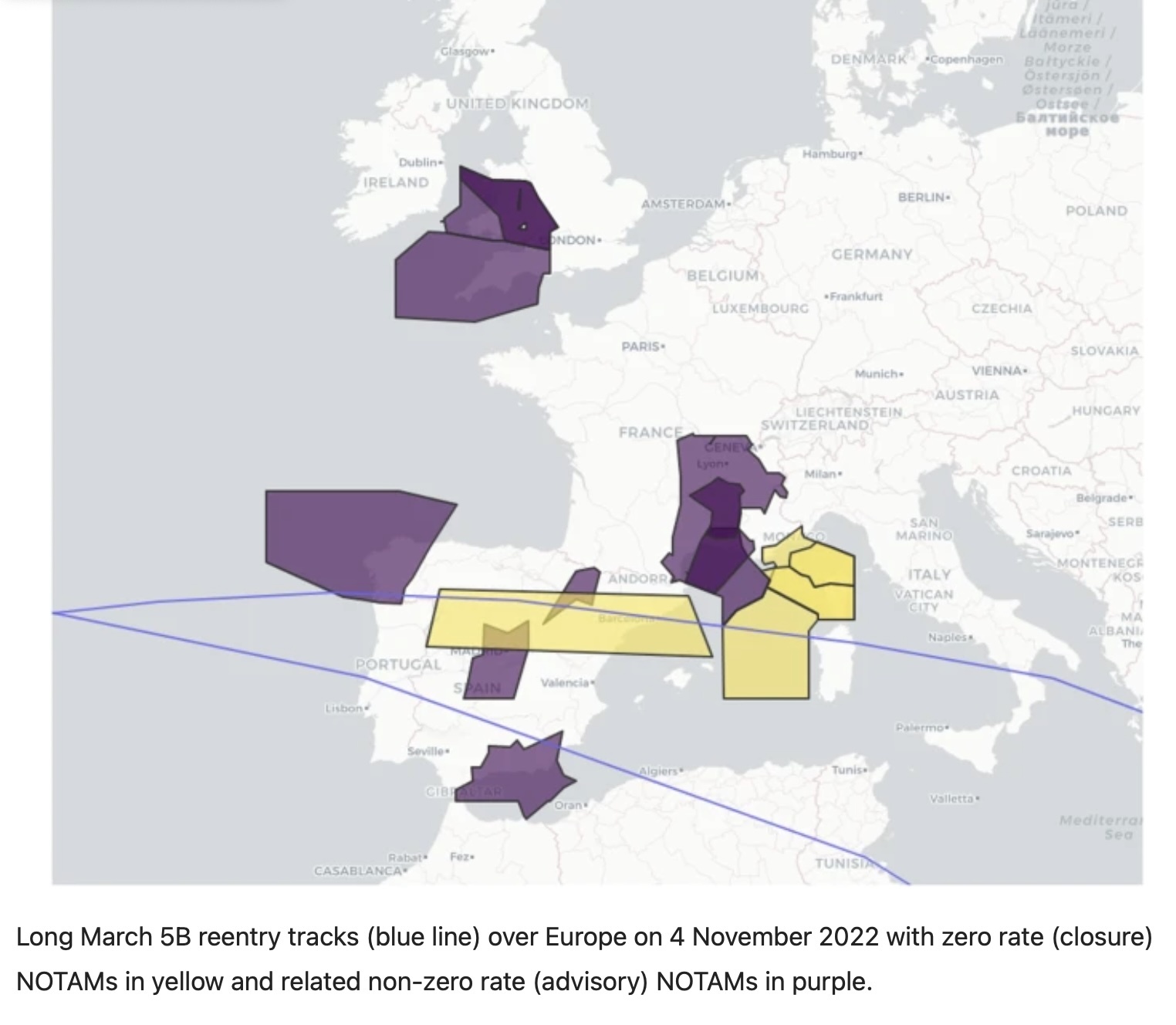
The final orbit track is the upper of the two paths—taken before the rocket body deorbited in
the Pacific. Had it not deorbited, it would have followed the lower track approximately 1.5 h
3
after the first pass. Image from EUROCONTROL . Note the designations employed do not
imply the expression of any opinion whatsoever on the part of EUROCONTROL concerning
the legal status of any country, territory, city, or area or of its authorities, or concerning the
delimitation of its frontiers or boundaries.
This was the first time that airspace was closed due to an uncontrolled reentry, though
4,5
warning NOTAMs have been issued for numerous reentries, as have EASA SIBs .
The aggregate probability of reentry debris striking an aircraft is small. However, since an
aircraft strike can lead to mass casualties, the risk arising from such an event is of real and
growing concern. The number of daily flights has almost doubled since 2000, with the
number of passengers increasing by over 250% 6,7
. The trackable objects in orbit have more
8 9
than doubled in the last decade , and large reentries occur almost weekly . There were a
record 212 successful launches in 2023, from which 128 rocket bodies were abandoned in
10
orbit to reenter uncontrolled .
Uncontrolled satellite reentries are also risky, but rocket bodies present a particular hazard as
they are often large and less likely to burn up entirely. And since many rocket bodies remain in
orbit for years before reentering, there has been an accumulation of these dangerous objects:
as of June 2024, there are more than 2300 of them in orbit, destined to eventually return to
11
Earth .
There are numerous instances of aircraft being struck by objects while flying at high altitude,
though attribution to reentry debris is difficult 12
. Even small debris poses an acute risk
because the speed of the aircraft contributes to the total kinetic energy of the collision—the
speed of the aircraft is much faster than that of the falling debris 13
. Estimates suggest that
debris as small as one gram could damage an aircraft, particularly if it strikes a windshield or
is ingested by an engine 14
. Nine-gram steel cubes have been shown to perforate aircraft
fuselages 15
, and debris with mass greater than 300 g could result in a catastrophic incident,
16
i.e., total aircraft loss .
A 2021 analysis by The Aerospace Corporation found the probability of a fatal aircraft collision
with reentry debris to be for that year, i.e., almost 1 in 100,000. When the reentries
from twelve future megaconstellations were included, this probability was predicted to rise to
(7 in 10,000 per year) in 2035. Because each aircraft carries many passengers, the
2021 annual risk of one or more casualties from debris-aircraft collisions was estimated to be
17
0.1%, rising to 0.84% by 2035 .
These are aggregate probabilities involving many future reentries, but the risks from individual
reentries may rise to a level where a safety concern is present. For example, though not an
uncontrolled reentry, the 2003 Space Shuttle Columbia disaster saw numerous flights
continuing under the falling debris from the exploded spacecraft. Distributed over hundreds
of kilometers, the debris fell for a surprisingly long time: most of the debris fell within 40 min,
with confetti-like pieces lingering for up to 2 h. Post-event analyses estimated that the risk to
18
aircraft in the area was 0.3–10% .
In the United Kingdom, the National Space Operations Centre monitors daily uncontrolled
reentries 19
, the Civil Aviation Authority is notified if the risk of a reentry in UK airspace is
above 1%, and an airspace closure considered if the risk is above 5% 20
. Yet safety-oriented
actions, such as precautionary airspace closures, have their own consequences. One is the
operational risk of diverting many aircraft; another is the economic impact.
Each delayed flight accrues numerous costs, including costs to airlines (staff costs and
knock-on scheduling issues), costs to passengers (value-of-time costs), and wider economic
impacts. Precautionary airspace closures from reentries have been estimated to cost
potentially up to tens of millions of dollars 21
. In the case of the November 2022 LM-5B
reentry, this is a cost that was paid by the airlines and their passengers. But it was created by
the space industry. The space industry is thus exporting negative externalities onto the
aviation industry. As we have explained elsewhere, the “launch state” could be liable under
international law, not just for any physical damage that might occur, but for the economic
3
damage of a precautionary airspace closure .
Airspace closures are a blunt mechanism to reduce risk, but national authorities may decide
this is preferrable to other options, particularly when reentry risks are hard to quantify, as we
discuss below. The November 2022 airspace closure is unlikely to be the last. Here, we model
probabilities for reentries over regions with high air traffic densities, as well as the resulting
risks to aircraft in flight, based on flight data from 2023. We then discuss the possible
consequences of preventive actions and the difficulties this creates for policymakers.
Results
Aircraft distribution
Using Automatic Dependent Surveillance (ADS) transponder data used to track aircraft, we
modelled the global distribution of aircraft in 2023 to find regions of high-density air traffic.
Here, air traffic density is a column density representing the number of aircraft in the air per
km 2
above a given location. Figure 2 shows the hourly number of aircraft transmitting location
information throughout the first day of each month in 2023. The date of 1 September 2023
had the maximum number of transmitters in this sample, at 18,318 at 1600 UTC. The peak
number of aircraft transmitting for any area is generally found in the late afternoon local time,
falling to a minimum at night. On average, 13,197 aircraft were transmitting transponder
signals at any given time during this 24-h period. Since flight volumes are expected to
increase in 2024 and beyond, we use 1 September 2023 for our models 22
, hereafter DS23.
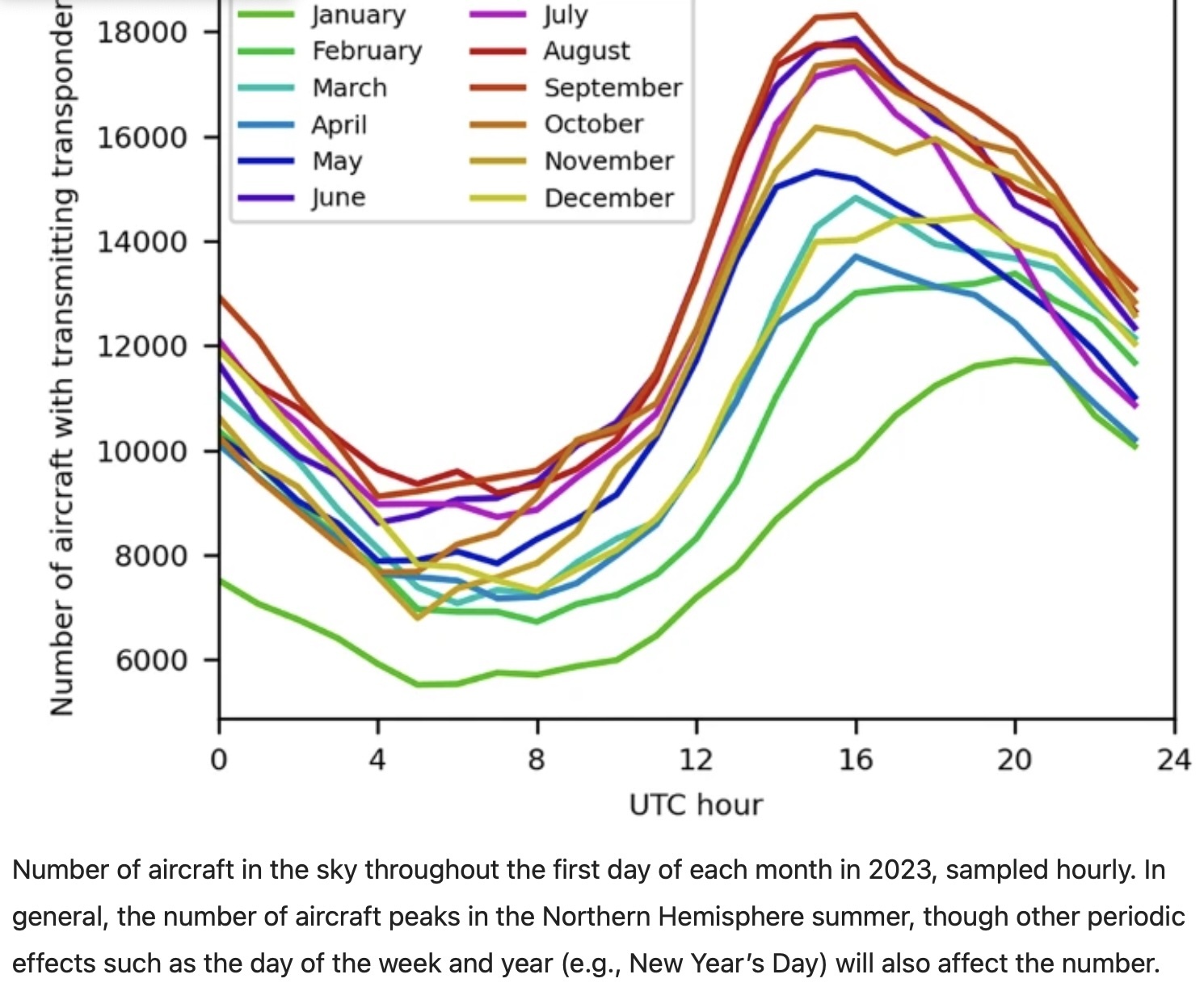
Over 500 aircraft types were found in DS23. Some of the aircraft are small general aviation
aircraft which have a lower area exposed to reentry debris than larger commercial aircraft; for
example, there were 950 Cessna 172s at 1600 UTC. However, of the top 10 most common
aircraft, eight were commercial airliners, including 1421 Boeing 737s, 1037 Airbus A320s and
571 Airbus A321s.
Casualty expectation
Since each aircraft is moving at considerable speed, the total ‘exposed area’ to debris is
larger than the actual surface area of the aircraft. We assume an average exposed area for all
aircraft (see “Methods”), and that the uncertainties in other aspects of this modelling will
outweigh this simplification.
By multiplying the air traffic density at each hour with the rocket body weighting function
(scaled for 1 h) and the exposed area, we obtain an average hourly collision expectation for
DS23 of and a total day collision expectation of . If every day in
2023 had the same flight distribution as September 1, the year’s collision expectation would
be . This corresponds to an annual probability of a collision between a rocket
body and an aircraft of (1 in 430,000) in 2023. This number is conservative
because it assumes that the rocket body remains in one piece; i.e., just one piece of debris
per reentry. This number is also lower than The Aerospace Corporation estimate for 2021
discussed above, but that calculation included reentering satellites and multiple debris pieces
per object 17
. Assuming 200 people per aircraft, the corresponding 2023 casualty risk due to
reentry debris from rocket bodies striking aircraft is , or 1 in 2200.
High air traffic density effects
The above is a model for the collision risk to aircraft. The risk of a reentry disrupting aircraft
operations is different altogether. We model this as the probability that a reentry will occur
over a given air traffic density threshold, as outlined in the “Methods” section. Firstly, Figs. 3
and 4 show the maximum air traffic density found in each grid cell for DS23, with aircraft
distribution samples taken every 10 s.
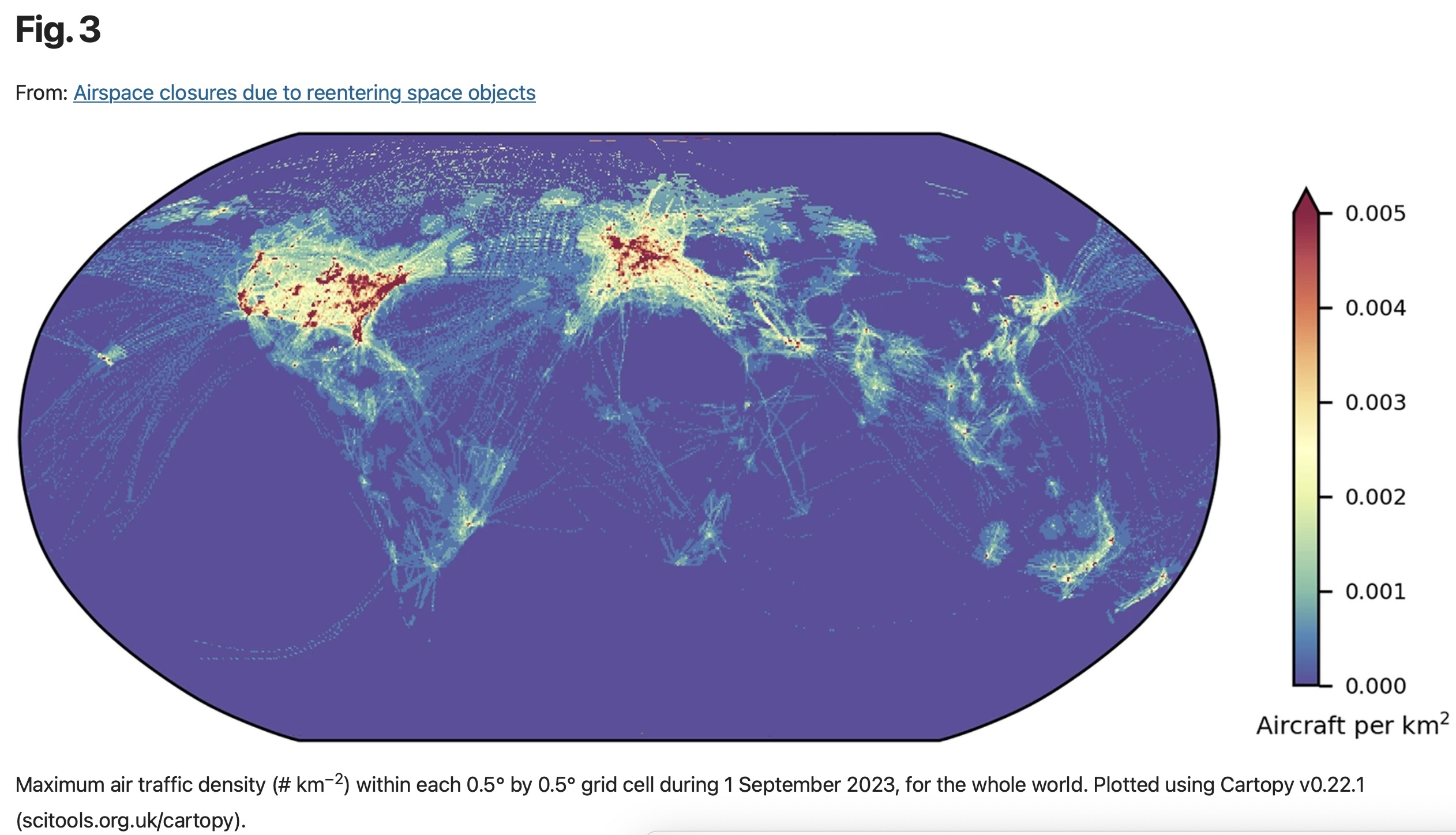
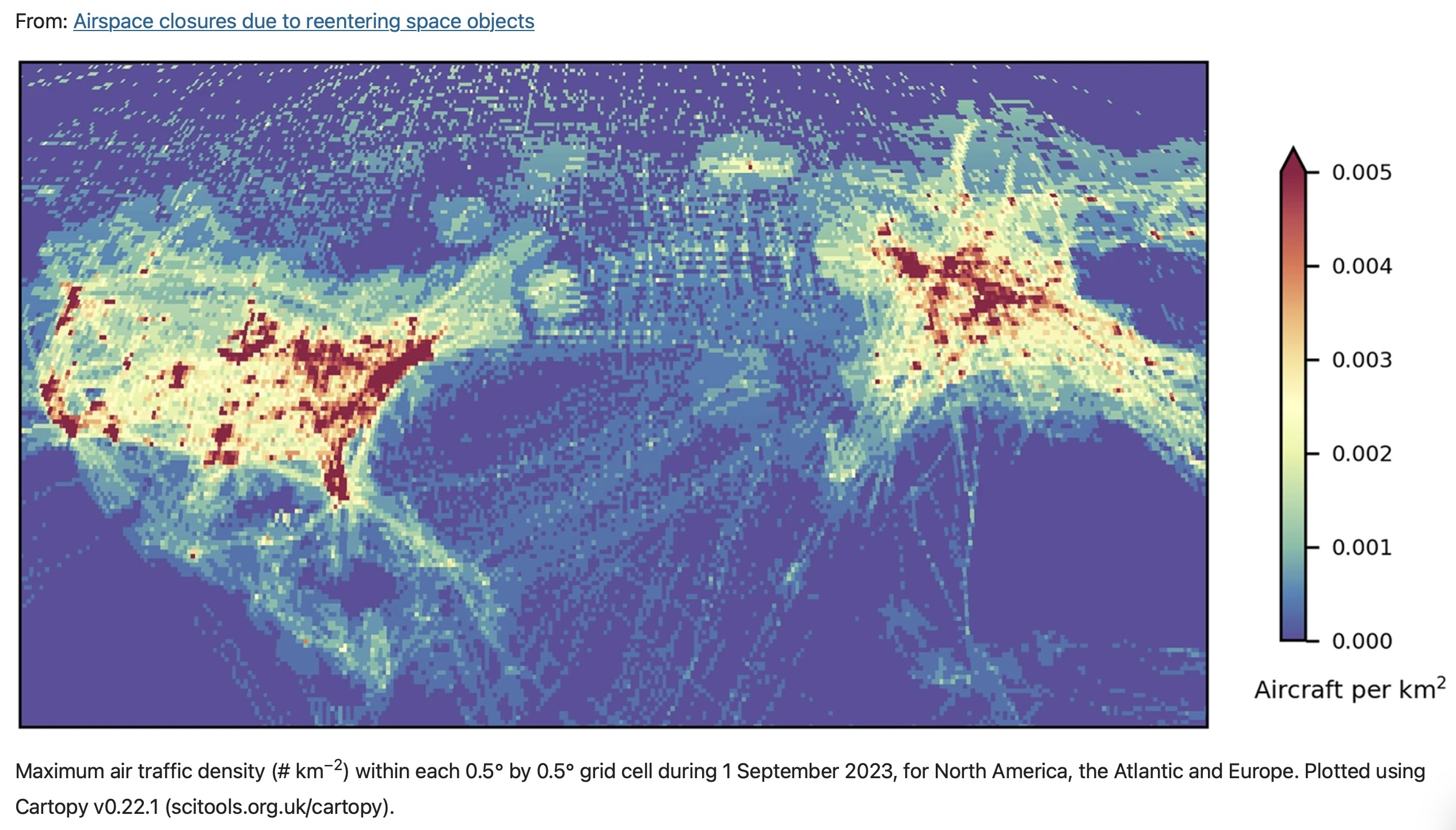
Airspace with particularly dense air traffic is found in the United States, Europe, and the Asia-
Pacific, including Japan, eastern China and Australia. The maximum air traffic density of
2
aircraft transmitters in DS23 was 0.054 per km , observed around Denver, Colorado. This is
2
on average one aircraft every 18 km . Because modelling air traffic densities can be complex,
and there is no clear definition for high-density traffic, we use this peak density as a reference
for various thresholds.
Considering densities that are 50% of the peak or greater (peak-50) selects only regions that
contain major airports. The associated annual probability of a rocket body reentering through
these relatively small regions is 0.8%, as shown in Table 1; Fig. 5. Lowering the threshold to
peak-10 (10% of the peak or greater) naturally includes a much larger portion of the globe but
is still focused on only busy regions around airports, such as the northeastern United States
and northern Europe. At this threshold, the annual reentry probability is 26%.
Notably, the airspace over southern Europe that was closed on 4 November 2022 is only
peak-5—around the world, there is a 75% chance of a reentry in such regions each year.
Again, as the threshold is decreased, larger regions of the globe are included, with peak-5
enclosing much more of the Asia-Pacific region and the US (see Fig. 5). However, peak-5
remains a relatively small fraction of the globe overall, with the high chance of a reentry within
that threshold reflecting the many reentries in a given year.
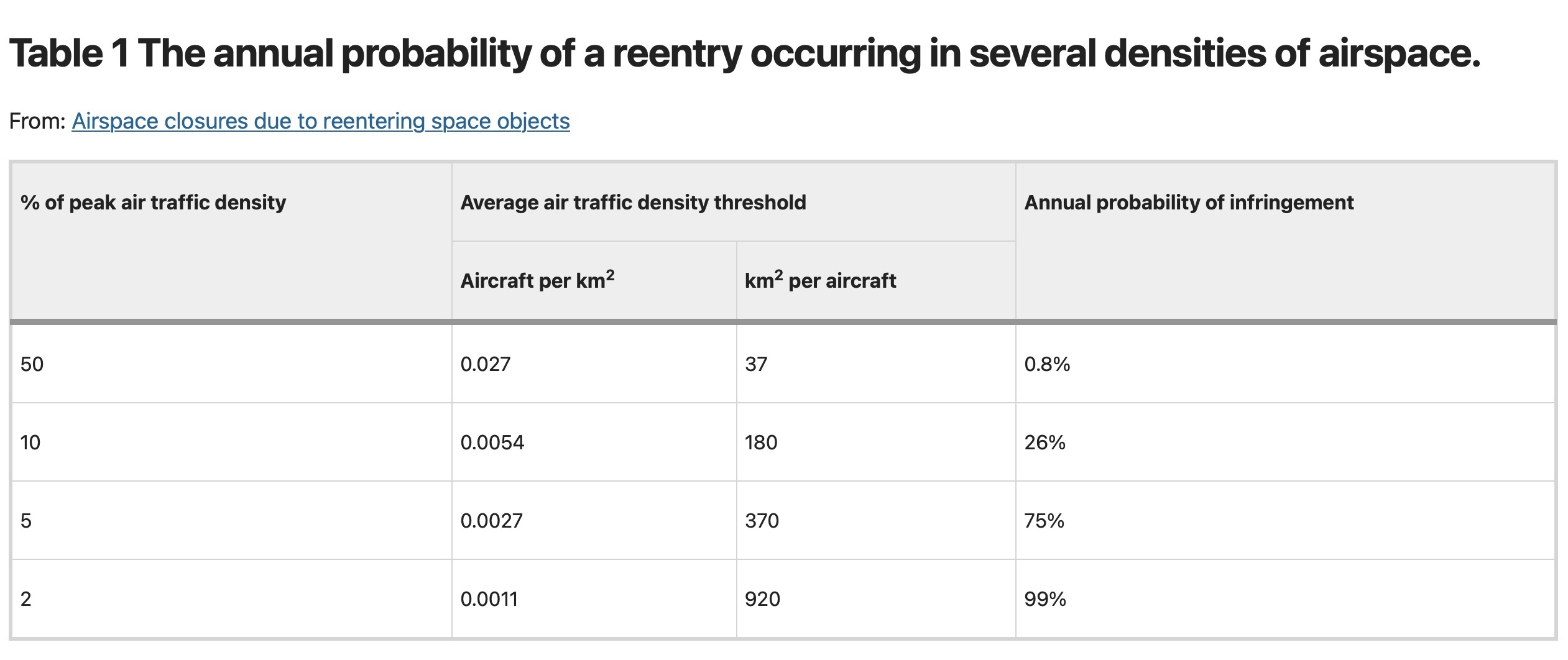
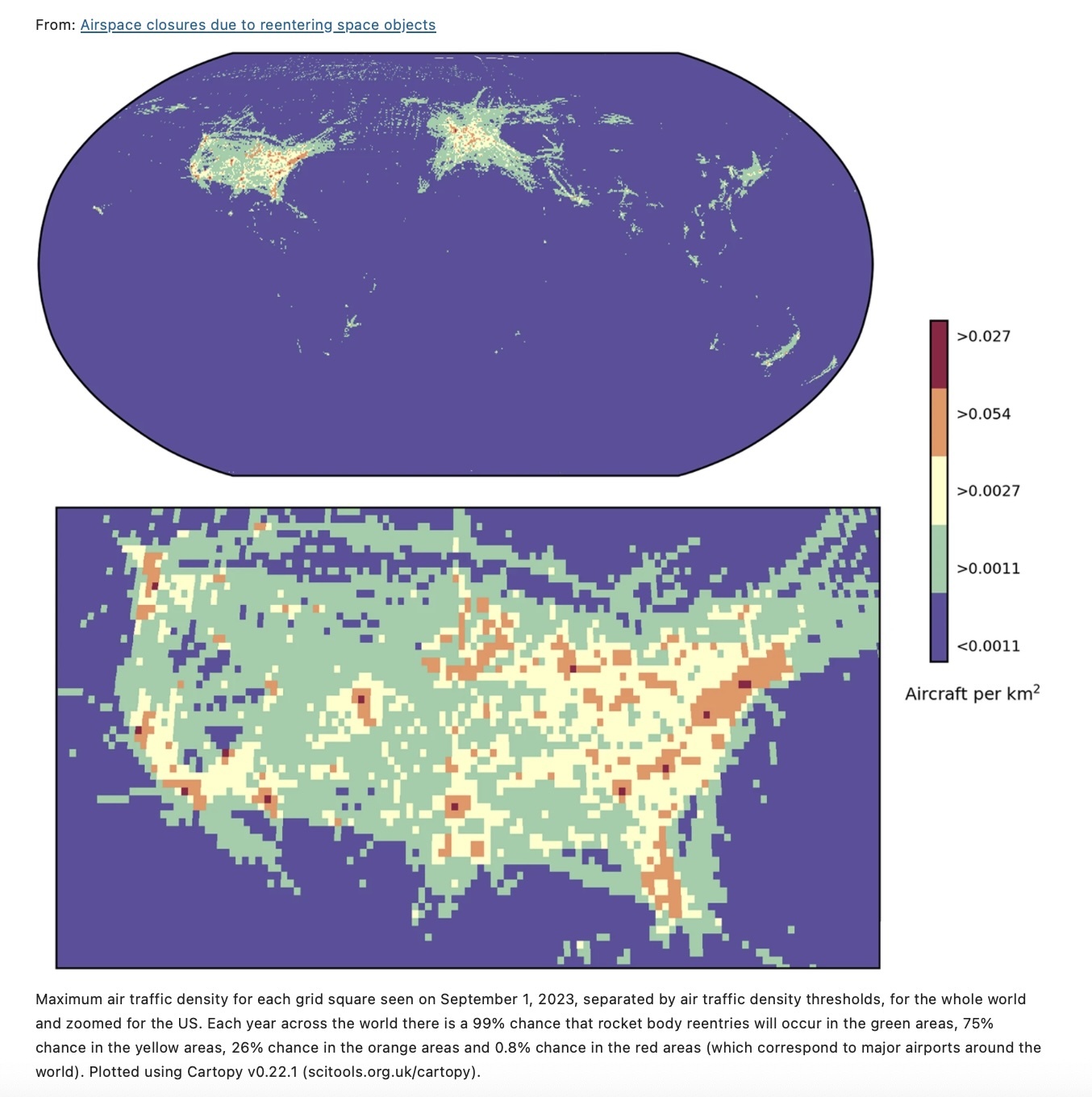
Discussion
The consequences of a collision between an uncontrolled reentering rocket body and an
aircraft would be devastating, not just to the people on board, but to the space and aviation
industries, as well as the global population that depends on their services.
To reiterate, the number of launches each year and the number of rocket bodies abandoned
in orbit are growing, as is the number of flights. The increase in launches is also connected to
the deployment of satellite megaconstellations of thousands of satellites, such as SpaceX’s
Starlink, which will in turn lead to many uncontrolled reentries of satellites. As they are unlikely
to be able to conduct controlled reentries, if these or other satellites do not burn up entirely,
17
then they too will add a significant factor to the actual collision risk .
As for airspace disruptions, there is an approximately 26% probability that a rocket body
reentry will occur in busy (peak-10) airspace each year, and a 75% chance that a reentry will
occur in airspace that is as busy (peak-5) as that closed by French and Spanish regulators in
response to a possible rocket body reentry in November 2022. These probabilities of
disruption are also increasing.
There are multiple factors that make estimating the risk for any specific reentry difficult.
Reentry location predictions have large uncertainties. The US Federal Aviation Administration
(FAA) notes that ‘Even 60 min prior to reentry, the potential area over which debris may fall is
still over 2000 km long’ 17
. Even if we knew exactly where the reentry would occur, we would
not know how the specific space objects might break up or what the resulting debris
distribution would be. What we do know is that even a small piece of debris could be
devastating to an aircraft. In addition, unlike the on-ground casualty risk, neither the reentry
risk to aircraft nor the probability of air traffic disruptions in general are included in most pre-
launch analyses.
On-ground casualty risks are commonly evaluated against the guideline of a 1 in 10,000 risk
threshold 23
but setting and applying a comparable threshold for aviation will be difficult. The
specific risk will be affected by factors such as the growth in flights, the actual exposed area
of aircraft, and the local time of day of reentry (which is not known in advance). Models based
on annual averages will do little to reassure national authorities that any given reentry in their
airspace does not pose a risk.
In some cases, due to the above uncertainties, national authorities may preemptively close
airspace until there is no longer a reentry risk, as occurred in November 2022. In other cases,
national authorities might choose to leave the airspace open, based on the low aggregate
probability of a collision.
Otherwise, authorities may aim to balance the collision risk against the economic costs of an
airspace closure. But both the risk and the economic costs scale with the number of aircraft
in the area at that time. Nevertheless, authorities will be faced with difficult choices in even
low air traffic density regions. There is also no obviously ‘right’ way to approach these
choices, which may raise legal and ethical considerations in addition to those of safety and
economics.
All of this leads us to ask: Why should authorities have to make these decisions in the first
place?
Uncontrolled rocket body reentries are a design choice, not a necessity. With engines that
can reignite and improved mission designs, operators can conduct controlled reentries,
directing the rocket body into a remote area of the ocean away from people and aircraft. But
8
currently, fewer than 35% of launches conduct controlled rocket body reentries . If controlled
reentries were used by all operators, the risks to people and aircraft would be greatly
reduced. This would also reduce the risk of on-orbit collisions, with their contribution to the
crisis of space debris. While US authorities have recently proposed rules to increase the use
24
of controlled reentries, these remain to be adopted and implemented .
Currently, there are more than 2300 rocket bodies in orbit, with this number increasing by
30–40 each year 25
. Nearly all of these will eventually return to Earth, on time scales that
range from months to centuries. This means that, while a switch to controlled reentries will
reduce risks, national authorities will still have to plan for uncontrolled reentries in their
airspaces.
The aviation industry is aware of the risks from uncontrolled reentries. The issue has been
raised by the Air Line Pilots Association, International 26 17
, the FAA and EUROCONTROL, the
European airspace coordination organization 27
. The Secretary General of the International
Civil Aviation Organization highlighted the growing risks at a February 2023 workshop hosted
by the Outer Space Institute, McGill Institute of Air and Space Law, and International
Association for the Advancement of Space Safety 12
. The workshop participants, including
engineers, pilots, air traffic controllers, reentry experts, lawyers, and space policy experts,
adopted the Montreal Recommendations on Aviation Safety and Uncontrolled Space Object
28
Reentries, which are available at .
Through its continued use of uncontrolled reentries, the space industry is imposing risks and
costs on the aviation industry, air crews and passengers. Policy and legal changes are needed
now, before a terrible accident occurs, and before more disruption results from sudden
airspace closures.
Methods
Risk to aircraft
To calculate the risk of an aircraft strike from space debris, we first model the reentry and
aircraft distributions. We then overlay these two distributions to find the collision expectation,
analogous to the on-ground casualty risk. This is the same general method used in 13 29
and
and is outlined here.
When viewed in aggregate, space object reentries are equally likely to occur at any longitude,
though the latitudinal distribution will be defined by the space object’s orbital inclination. An
object with inclination 90° will be equally likely to reenter at any latitude, and an object with an
inclination of 0° will certainly reenter over the equator. All other inclinations will result in the
space object reentering between northern and southern latitudes corresponding to its
inclination value, creating a U-shaped function for the latitude-dependent reentry probability
13,30
density (see, e.g ).
If we sum the resulting probability density functions for each reentering space object, we
build a weighting function showing on average the latitudes where reentries are most likely to
occur. If we propagate this over all longitudes, we can work out the likelihood of each area on
Earth having a space object reenter over it. This method was used in our previous work
23,30
estimating the on-ground casualty risk from reentering rocket bodies .
To determine the weighting function, we use the uncontrolled rocket body reentries from the
past decade (March 2014–March 2024) as a proxy for the current reentry distribution. We
only consider rocket body reentries because they present some of the largest reentry events
and are less likely to demise entirely in the atmosphere. However, satellite megaconstellations
could create considerable additional risks, provided that they too do not demise entirely, as
highlighted in a September 2023 FAA report 17
. We use rocket body reentry data from the
General Catalogue of Artificial Space Objects, finding that 528 upper stages and 482 rocket
components have reentered uncontrolled since March 2014: almost two rocket bodies per
31
week .
In any given airspace, a certain number of aircraft will be flying at any time. Viewed from
above, this will correspond to an air traffic density (i.e., number of aircraft per unit area).
Furthermore, each aircraft will itself have a collisional area that could come into contact with
reentering debris. If the aircraft were stationary, this would be its top surface area. However,
both objects are moving and the effective exposed area is larger. According to 13
, a Boeing
2
737 has an exposed area of just under 3000 m , and a Boeing 747 has an exposed area of
2 2
over 9000 m . The FAA report assumed an average area of 1000 m , and we too use this
value 17
. This area is assumed to be much larger than the area of the reentering space object
and so we neglect the rocket body area, thus assuming that a rocket body is a single falling
object. This is very conservative, since any rocket body will likely break into many pieces upon
reentry and those pieces would be spread over a wide area, potentially hundreds of
kilometres long. We do not include such spread in our model.
By multiplying the rocket body weighting function with the air traffic density and the average
exposed area of an aircraft, we determine the collision expectation (E) of an aircraft strike per
event, , where W is the weighting function, N is the air traffic density and is
the aircraft effective exposed area. Recall that air traffic density is used here as a column
density, representing the number of aircraft in the air per km 2
over a given location. For the
collision risk calculations the air traffic density was sampled hourly and integrated with thecollision risk calculations, the air traffic density was sampled hourly and integrated with the
same weighting function. The calculation is done over one day (DS23), which is then used for
estimating the yearly risk in the context of increasing annual flights. Assuming events are
independent and hence following Poisson distributions, we can derive a probability of one or
more aircraft collisions ( ) of , where q is the number of
independent events, as well as a casualty risk (R) of R = E q n. where n is the assumed number
of casualties per event.
Risk to airspace
Airspace itself is complex, comprising many different categories of controlled and
uncontrolled airspace which vary around the world. It is divided into many zones, such as
flight information regions and terminal control areas. The boundaries of these zones often
extend beyond geographical borders. We do not attempt to model airspace itself here. Rather,
we seek to characterize possible air traffic densities so that we can determine probabilities
that a rocket body will reenter within given thresholds.
We approach this problem by dividing the world into a 0.5° latitude by 0.5° longitude grid. We
then find the maximum air traffic density for each grid cell at 10 s intervals on 1 September
2023 using aircraft transponder data. After selecting several density thresholds based on the
overall maximum air traffic density, we create binary maps for various thresholds, whereby
cells with maximum densities above the threshold are 1 and all other cells are 0. The reentry
weighting function is then multiplied by this threshold mask and summed to give the
expectation E for a reentry above the given threshold. The probability P of one or more
reentries occurring within regions above the threshold is . A reentry may
not occur at the time of maximum air traffic density, but these higher density areas are likely
to be managed airspaces where the reentry will still be of concern, and this factor could
dominate the decision-making.
Aircraft data
The number of aircraft in the sky at any one time varies periodically, such as by time of day
and day of the year, as well as non-periodically. Aircraft traffic has grown over the past few
6
decades—peaking in 2019 before reducing sharply through the COVID-19 pandemic . By the
22
end of 2023 it had recovered to the 2019 level and continues to grow .
We use aircraft position data created by transponders fitted to nearly all commercial aircraft
and made available by ADSBexchange 32
. Free sample data are provided for the first day of
every month. Of all the sample days since January 2019, the day of 1 September 2023 had
the most aircraft transponder transmissions at any one time. The peak number of
ADSBexchange transponder readings on this day when sampled hourly was 18,318 at 1600
UTC. However, only 14,430 of these readings contained position coordinates (ADS-B and
ADS-C). The remaining were other broadcast types, including over 1200 Mode-S
transponders transmissions, which do not transmit position data and are generally used on
smaller aircraft. We thus use the positional data for 1 September 2023 sampled every 10 s,
while noting that there are variations in aircraft flight volumes, and our sample is biased by the
transponder data available.
Quelle: scientific reports
